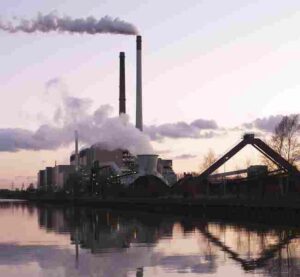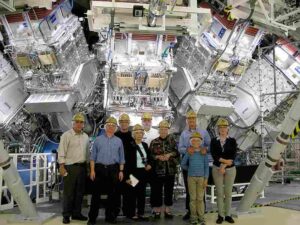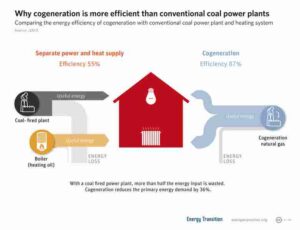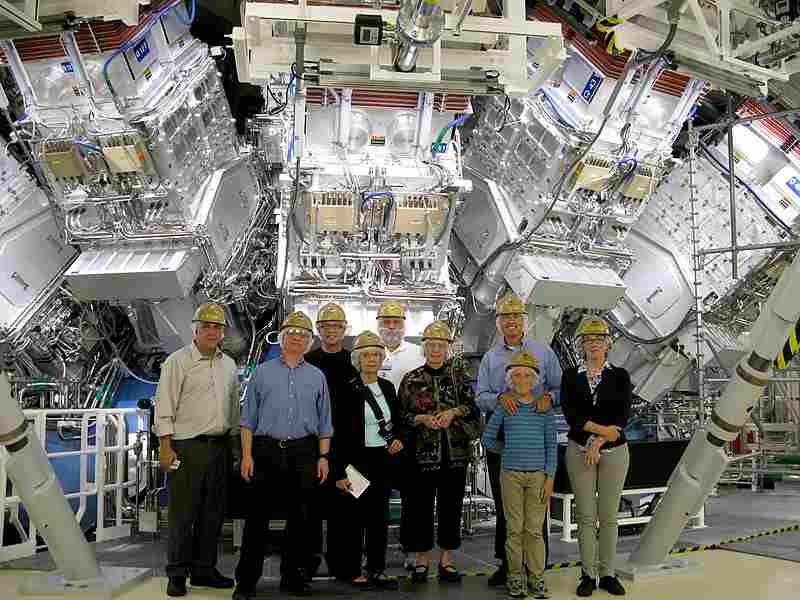9 Advantages of Nuclear Fusion Discussed
Advantages of nuclear fusion include carbon-free operation, high energy efficiency, economic sustainability, high energy production potential, relatively minimal fuel consumption, low space demands, contribution to energy security, and cogeneration opportunity.
This article discusses the advantages of nuclear fusion, as follows;
1). Carbon Free Process (as one of the Advantages of Nuclear Fusion)
One of the notable advantages of nuclear fusion as a prospective energy production method is its status as a carbon-free process [6].
This characteristic makes nuclear fusion highly beneficial for addressing environmental issues related to climate change, and transitioning to cleaner energy sources. Some ways in which the carbon-free nature of nuclear fusion makes it advantageous, are discussed in this section.
Carbon-Free Process in Nuclear Fusion
Benefits associated with the non carbon-intensive nature of nuclear fusion include; zero greenhouse emissions, mitigation of climate change, long-term low-carbon energy; and general environmental friendliness.
Nuclear fusion, like nuclear fission, does not produce or emit carbon dioxide (CO2), or other greenhouse gases into the atmosphere during its process of energy production. This attribute is in stark contrast to fossil fuel-based non renewable energy sources, such as coal, petroleum, and natural gas, which are known to release substantial amounts of CO2 when burned for electricity generation [2].

The fact that greenhouse gas emissions are absent from fusion reactions, means that nuclear fusion can be viewed as a promising approach for mitigating climate change in the energy industry. It offers a relatively clean and sustainable energy source that can replace (or at least support) fossil fuels, thereby reducing the overall carbon footprint of energy production.
Nuclear fusion holds the potential to provide a long-term source of low-carbon electricity. This prospect is especially valuable in the context of energy transition, to sustainable systems, as fusion could contribute to reducing the level of reliance on fossil fuels and decreasing the overall environmental impact of energy generation.
As all these imply, fusion is one of the most environmentally friendly mediums of energy production. It does not contribute to harmful atmospheric emissions, air pollution, or global warming. Rather, it offers a more sustainable, cleaner alternative to conventional energy sources.
Additional Notes and Reiterations On the Emission Potential of Nuclear Fusion
Nuclear fusion does not emit greenhouse gases or other harmful atmospheric emissions in any significant amounts; during its energy production process.
Nuclear fusion is considered a zero-emission energy mechanism because it does not release greenhouse gases or pollutants into the environment.
What nuclear fusion emits is energy in the form of heat and light. It does not emit carbon dioxide or other harmful airborne toxins typically associated with fossil fuel combustion.
2). Relatively Minimal and Short-Lived Waste Production
Another of the notable advantages of nuclear fusion as a prospective method of energy production, is its relatively minimal and short-lived waste which it produces. This characteristic makes nuclear fusion highly beneficial for several reasons, some of which are discussed in the subsection below;
Attributes and Benefits of the Pattern of Waste Production in Nuclear Fusion
Attributes and benefits of waste production in nuclear fusion include; short-lived radioactive waste, reduced environmental impact, improved waste management, and alignment with sustainable development goals.
Unlike nuclear fission, which generates long-lived radioactive waste that is persistent and can remain hazardous for thousands of years, nuclear fusion produces short-lived radioactive waste.
The radioactive byproducts of fusion reactions have relatively short half-lives, which lie typically in the range of 50 to 100 years, with some like helium-3 being stable isotopes [1]. This implies that the waste generated by fusion will become significantly less radioactive and less hazardous in a relatively short period compared to fission.
Also, the short-lived nature of fusion waste translates into a reduced overall environmental impact. Fusion reactors generate waste that is less harmful and poses fewer long-term risks to the ecosystem, compared to the radioactive waste produced by fission reactors. This is in alignment with the goal of minimizing the environmental footprint of energy production to achieve sustainability.
Due to its relatively shorter half-life, fusion waste is easier to manage and dispose of. This ease of handling allows for more efficient and cost-effective waste management strategies. In addition, the reduced longevity of fusion waste simplifies the planning and execution of long-term waste storage and disposal schemes.
Fusion waste's shorter half-life implies that it poses significantly less social, economic and environmental risk to future generations. Unlike fission waste, which requires long-term safeguards and isolation, fusion waste becomes less radioactive within a few decades. This reduces the burden on future generations in terms of safety precautions and waste management.
As stated earlier, the minimal and short-lived waste produced by nuclear fusion aligns with environmental and sustainability goals. It supports efforts to reduce the long-term environmental impact of energy consumption, making fusion an attractive option for addressing climate change and reducing the legacy and impact of nuclear waste.
Additional Notes and Reiterations On the Relative Low Persistence and Risk of Fusion Wastes
Fusion waste typically consists of short-lived radioactive byproducts with half-lives in the range of 50 to 100 years.
Nuclear fusion produces less nuclear waste compared to nuclear fission, and the waste it generates is short-lived and less environmentally hazardous.
3). High Energy Efficiency (as one of the Advantages of Nuclear Fusion)
High energy efficiency is one of the advantages associate with nuclear fusion as a prospective energy production method. This characteristic makes nuclear fusion highly beneficial in various ways, which are highlighted within this section.
Benefits of High Energy Efficiency of Nuclear Fusion
The energy of efficiency of nuclear fusion is beneficial because it leads to high energy yield, abundant fuel supply, reduced fuel consumption, low environmental impact, energy source complementation, and long-term sustainability.
Fusion reactions have the potential to generate significantly more energy compared to fission reactions. When two light atomic nuclei, such as hydrogen isotopes, fuse to form a heavier nucleus, they release a tremendous amount of energy. In fact, fusion can produce several times more energy per kilogram of fuel than fission, which is used in conventional nuclear power plants [7].

Fusion fuel sources, such as tritium and deuterium, are abundant and widely available. Deuterium can be extracted from water, while tritium can be generated from lithium, which in turn can also be derived from seawater [5]. This ensures a long-term and sustainable supply of fuel for fusion reactors.
The reactors used in nuclear fusion can be highly fuel-efficient. A gigawatt-scale fusion power station may require less than one tonne of fuel during an entire year's operation, which is significantly less than the fuel demands of conventional power plants. This reduced fuel consumption rate contributes to both environmental sustainability and cost-effectiveness.
Fusion's high energy efficiency translates into lower environmental impact. This is because efficient utilization of fuel resources implies less waste and reduced atmospheric emissions, making fusion a relatively clean and environmentally friendly energy source.
The ability of fusion to produce large amounts of energy makes it a suitable complementary energy source that can augment existing methods of power generation. It can help to meet the growing global demand for electricity while reducing dependence on fossil fuels.
Lastly, the high energy efficiency of fusion positions it as a potential long-term energy solution that can provide a reliable and stable energy outlet for generations to come. Its potential to generate large amounts of energy from relatively small amounts of fuel ensures its sustainability in both environmental and socioeconomic contexts.
Additional Notes On the Efficiency of Nuclear Fusion
Nuclear fusion is more energy-efficient than fission. Fusion reactions have the potential to release significantly higher magnitude of energy per unit of fuel compared to fission reactions.
Nuclear fusion has the potential to produce vast amounts of energy, with fusion reactions releasing several times more energy than fission reactions.
One kilogram of fusion fuel, such as deuterium and tritium, has the potential to release a substantial amount of energy, equivalent to 3.37 x 10^14 Joules, which can provide the energy requirements of a large power station for a day.
4). Economic Sustainability
Economic sustainability is one of the key benefits of nuclear fusion as a prospective means of energy production. Some reasons why this is beneficial are discussed below;
Economic Benefits Associated With Nuclear Fusion
The potential economic benefits of nuclear fusion include low fuel costs, minimal fuel requirements, long-tern energy supply, reduced waste disposal costs, economic growth, and energy dependence.
Fusion reactors primarily utilize isotopes of hydrogen, such as tritium, as fuel. These isotopes (and/or their parent materials) are relatively abundant and widely available, which translates to low fuel costs. Unlike fossil fuels, which are subject to price fluctuations and resource depletion, fusion fuel can be considered sustainable and affordable.
Generally, fusion reactions are highly efficient, so that a small amount of fuel is capable of producing a substantial amount of energy. This efficiency reduces the overall fuel demand for fusion reactors, and contributes to cost-effectiveness.
On the basis of prospects highlighted so far, fusion has the potential to provide a long-term and stable supply of energy. With abundant fuel reserves and efficient energy production, fusion can meet the energy demands of society for generations to come, reducing the need for frequent infrastructure investments and urgent fuel-related research/development.
Fusion reactions generate minimal waste, and the waste produced, such as helium, is often non-radioactive and can be safely released into the environment. This reduces the costs associated with radioactive waste disposal and long-term storage/sequestration in repositories.

The development and deployment of fusion technology is capable of stimulating economic growth. It establishes job opportunities in research, development, construction, and maintenance of fusion facilities. Additionally, the fusion industry can attract investments and promote innovation, both of which contribute to the local and global economy.
Fusion's economic sustainability reduces dependence on fossil fuels and imports of energy resources; thereby strengthening energy independence. This energy independence can enhance a nation's economic stability and resilience.
Additional Notes and Reiterations on the Economic Prospects of Nuclear Fusion
Nuclear fusion benefits society by providing a clean, sustainable, and economically viable source of energy. It reduces greenhouse gas emissions, mitigates climate change, ensures energy security, and creates viable economic opportunities.
Fusion energy has the potential to be economically profitable, especially with ongoing advancements in technology, improved efficiency, and standardized production. Research and development efforts also aim to make fusion commercially competitive with other energy sources.
5). High Energy Production Potential
High energy production potential is one of the primary advantages of nuclear fusion as a prospective method of energy production. It shares close ties with other advantages like high efficiency and low fuel consumption rate. Further discussion on this aspect of nuclear fusion is provided below.
Benefits of the High Energy Potential of Nuclear Fusion
Benefits that point to the energy potential of nuclear fusion include; massive energy release, sustainable supply, reduced resource consumption, clean energy generation, and high energy density.
As stated multiple times so far, nuclear fusion reactions release a tremendous amount of energy, much greater than other energy sources. This energy output results from the conversion of mass into energy, as dictated by Einstein's famous equation, E=mc² [4].
When light atomic nuclei combine to form a heavier nucleus, the mass of the resulting nucleus is slightly less than the sum of the masses of the original nuclei. The difference in mass is converted into a significant amount of energy that is released from the reactive system.
The high energy production potential of fusion ensures a sustainable and virtually limitless supply of energy. Fusion fuel, mainly deuterium-tritium, is abundant and available in most parts of the world. A small amount of fusion fuel can generate an enormous amount of energy, and has the potential to meet global energy demands for an extended period of time.
Fusion therefore requires minimal fuel resources compared to other energy-releasing mechanisms. This efficiency reduces resource depletion and minimizes environmental impact. It also decreases the need for frequent fuel extraction, transportation, and storage.
Clean energy is produced from fusion reactions produce, with virtually no harmful emissions. Unlike fossil fuels, which release greenhouse gases and several pollutants, fusion is a clean and environmentally friendly energy option. It can contribute to mitigating climate change and reducing air pollution.
Both fusion fuels and reactions have a high energy density, which implies that a small volume of fusion fuel can store a relatively large amount of energy. This characteristic is advantageous for power generation and transportation applications, and makes fusion an attractive option for various sectors.
Additional Notes On Fusion Energy Potential
Nuclear fusion releases high energy because it involves the combination of light atomic nuclei to form a single, heavier nucleus. This process results in the conversion of a small amount of mass into a large amount of energy, as per Einstein's principle of mass-energy equivalence (E=mc²).
While initiating nuclear fusion reactions requires the input of substantial energy to achieve the extremely high temperatures and pressures needed, the energy produced through fusion far exceeds the energy input, making it a net energy gain process. Once fusion is initiated, it becomes highly efficient in terms of energy production.
6). Relatively Minimal Fuel Consumption
Relatively minimal fuel consumption is an advantage of nuclear fusion, which can be exploited through the implementation of this energy production method. This attribute makes nuclear fusion highly beneficial for several reasons, some of which are highlighted further in this section.
How Minimal Fuel Consumption Makes Nuclear Fusion Beneficial
As a result of the low rate at which it consumes fuel, nuclear fusion systems and methods can be said to have benefits like; abundant furl supply, reduced resource dependency, minimal fuel consumption, energy efficiency, and sustainability.
Earlier sections of this article have acknowledged that fusion fuel sources, such ad deuterium and tritium, are readily available and abundant. Deuterium can be extracted inexpensively from seawater [3], which is a virtually limitless resource, and tritium can potentially be produced from the reaction of fusion-generated neutrons with naturally abundant lithium.
These fuel supplies have the potential to last for millions of years, thereby ensuring long-term energy sustainability.
Fusion reduces dependency on finite and environmentally impactful fuel resources. Unlike fossil fuels, which contribute immensely to pollution and climate change, fusion utilizes isotopes of hydrogen, the most abundant element in the universe. This reduces resource depletion concerns as well as environmental degradation associated with resource extraction.
Low rate of fuel consumption is an essential attribute of nuclear fusion reactions. For instance, a fusion plant envisioned for the second half of this century may only require 250 kilograms of fuel per year, which will consist of equal parts deuterium and tritium. In contrast, conventional energy sources and their generation systems, such as coal-fired power plants, often require millions of tonnes of fuel per year.
The energy efficiency of fusion is unparalleled, and estimated to amount to nearly four million times more energy per kilogram of fuel compared to chemical reactions like burning coal, oil, or gas. This high energy output with minimal fuel consumption makes fusion a highly efficient energy production method.
Lastly, the reliance of fusion on abundant and sustainable fuel sources can contribute to energy security and reduce geopolitical tensions related to resource availability and/or access. It is capable of ensuring a stable and sustainable energy supply for future generations.
Additional Notes on Fuel Consumption in Nuclear Fusion
The current best fuel for nuclear fusion reactors is deuterium-tritium (D-T) fuel.
This fuel reaches fusion conditions at lower temperatures compared to other elements and releases more energy than other fusion reactions. Deuterium and tritium are isotopes of hydrogen, which is the most abundant element in the universe.
Fusion reactors require minimal fuel consumption. Its fuel consumption rate is significantly low compared to conventional combustion mechanisms that require millions of tonnes of fuel per year.
7). Low Space Demands (as one of the Advantages of Nuclear Fusion)
Low space demands are among the notable advantages related to nuclear fusion as a prospective energy production method. This characteristic makes nuclear fusion highly beneficial for multiple reasons, some of which are discussed in this article.
Nuclear Fusion Benefits With Regards to Space Demand
In the area of space demand, some benefits that can be associated with nuclear energy are; small land footprint, high energy density, potential for compact designs, and scalability.
Fusion reactors require significantly less land compared to many other types of power generation systems. A typical 1,000-megawatt nuclear facility in the United States needs a little more than 1 square mile to operate.
This small land requirement is in stark contrast to wind farms, which may require 100-300 times more land area, and solar photovoltaic plants, which may require more than 6.5 times more space to produce the same amount of electricity.
The compact nature of fusion facilities minimizes their impact on the environment and local communities.
Fusion reactions release a massive amount of energy relative to the volume of fuel used. This high energy density allows fusion systems to be compact and highly efficient, requiring less physical space for energy production. This efficiency in land use is especially valuable in densely populated or limited-space areas.
Research in the field of fusion technology, is focused on developing compact fusion reactors. These compact designs in turn aim to maximize the efficiency of the magnetic field pressure, thereby enabling the development of devices that are 10 times smaller than previous concepts. Such compact fusion reactors can be deployed in various locations, including urban areas, without significant land requirements or socioeconomic disruption.
In line with the above explanation, fusion technology offers the potential for scalable designs, thereby allowing for the development of small-scale fusion reactors. These smaller reactors could cater to localized energy needs, and reduce the need for extensive land use associated with large-scale energy facilities.
Additional Notes On Space Demands Associated With Nuclear Fusion
Nuclear power has a relatively small land footprint. A nuclear energy facility, such as a nuclear power plant, requires from approximately 0.9 to 1.3 square miles per 1,000 megawatts of energy. This is considerably smaller than the land area required for many other forms of energy generation.
Small-scale fusion is possible and actively being explored. Compact fusion reactor designs aim to make fusion technology more accessible and versatile, potentially enabling small-scale fusion reactors to meet localized energy needs.
Advances in fusion research are focused on making fusion reactors as compact as possible. Some concepts aim to create fusion devices that are 10 times smaller than previous designs. The specific size of fusion reactors will depend on the technology and design innovations achieved in the future.
8). Nuclear Fusion Can Increase Energy Security
Increased energy security is a potential advantage of nuclear fusion as an energy production method. There are various ways in which this characteristic makes nuclear fusion highly beneficial. Some of them are highlighted in the subsection below.
Benefit(s) of Increased Energy Security in Nuclear Fusion
Through an abundant supply (relatively) of fuel resources, nuclear fusion has the potential to foster energy independence, while providing improved safety with minimal waste and environmental impact.
Nuclear fusion relies mainly on isotopes of hydrogen (deuterium and tritium), as fuel sources. As earlier pointed out, these resources can be derived from seawater and lithium respectively, which are naturally abundant.
This ensures a long-term, secure, and domestically sourced fuel supply, thereby reducing energy dependence on finite resources or geopolitically unstable (oil-producing) regions.
Nuclear fusion offers countries the opportunity to achieve energy independence by harnessing locally available raw materials like seawater and lithium. This can reduce reliance on imported fossil fuels and enhance national energy security.
Also, fusion is a relatively safe process. Fusion reactions occur at extremely high pressures and temperatures, and any disruptions or instability in the reaction lead to its automatic cessation. This self-limiting attribute ensures that the fusion process cannot spiral out of control, and minimizes the risk of accidents and catastrophic events.
As stated earlier, fusion does not produce long-lived, high-level nuclear waste, in contrast to some fission reactions. The type of radioactive waste generated is limited to short-lived, low-level radioactive materials that can be managed safely. In addition, fusion reactors do not emit harmful airborne substances like carbon dioxide or other greenhouse gases into the atmosphere, thereby fostering environmental sustainability and reducing the associated risks of climate change.
Additional Notes on Energy Security, and the Operational Safety of Nuclear Fusion
Nuclear fusion is considered a safe energy source due to its inherent characteristics. Fusion reactions are self-limiting, which means they naturally stop if the conditions become unstable. This makes fusion reactors highly resistant to catastrophic events or runaway reactions.
Fusion is safe because it is unlikely to lead to uncontrolled reactions or nuclear meltdowns. If the fusion process becomes unstable, it simply ceases to continue, thereby ensuring safety.
Nuclear fusion is generally considered safer than fossil fuels in terms of environmental and safety aspects. Fusion does not produce greenhouse gas emissions or contribute to air pollution, reducing health risks associated with fossil fuel use. Additionally, fusion's intrinsic safety features make it less prone to catastrophic accidents compared to some fossil fuel extraction and processing methods.
9). Opportunity for Cogeneration (as one of the Advantages of Nuclear Fusion)
Cogeneration, or combined heat and power (CHP), is an operational advantage of nuclear fusion (and all forms of nuclear power generation).
Cogeneration involves using the heat generated by a power plant for multiple purposes, rather than limiting its application to electricity generation. This section sheds light on the prospect of cogeneration in nuclear fusion systems, and how it makes fusion beneficial.
How Cogeneration Opportunities Add to the Benefit(s) of Nuclear Fusion
By facilitating cogeneration, nuclear fusion leads to efficient use of heat; diverse energy supply, energy efficiency, and environmental benefits.
In a nuclear fusion reactor, heat is a core byproduct of the fusion process. Cogeneration allows for the efficient utilization of this excess heat, which might otherwise be lost as waste energy. This heat can be harnessed for various applications.

Cogeneration in nuclear fusion facilities can address a range of energy demands beyond electricity generation. These include domestic heating, hydrogen production, seawater desalination, district heating or cooling, and various thermal industrial applications. By serving multiple energy needs, nuclear fusion can become a versatile and adaptable energy source.
Also, cogeneration can significantly increase the overall energy efficiency of a nuclear power plant, through energy conservation. By utilizing the excess heat, the energy efficiency level can be raised significantly above 60%, making the nuclear fusion process even more sustainable and resource-efficient.
Utilizing excess heat for applications such as domestic heating or hydrogen production contributes to reducing greenhouse gas emissions and reliance on fossil fuels. This aligns with sustainability goals and helps combat climate change.
Additional Notes on Cogeneration in Nuclear Energy Systems/Applications
Nuclear cogeneration is a concept where the heat generated by a nuclear power station is used not only for electricity generation but also for addressing additional energy demands, such as heating and hydrogen production, thereby reducing energy wastage.
Cogeneration opportunities in nuclear energy encompass a wide range of applications, including domestic heating, hydrogen production, seawater desalination, district heating or cooling, and various energy-demanding industrial processes. Cogeneration can enhance the versatility and resource efficiency of nuclear power plants.
Conclusion
Advantages of nuclear fusion are;
1. Carbon Free Process
2. Relatively Minimal and Short-Lived Waste Production
3. High Energy Efficiency Can be Achieved
4. Economic Sustainability
5. High Energy Production Potential
6. Relatively Minimal Fuel Consumption
7. Low Space Demands
8. Can Increase Energy Security
9. Can be Used for Cogeneration
References
1). Bulubașa, G.; Cristescu, I.; Bornea, A.; Zamfirache, M.; Stefan, L.; Ana, R. G. (2019). "Studies on helium-3 separation at Cernavoda nuclear power plant." Fusion Engineering and Design 146(4). Available at: https://doi.org/10.1016/j.fusengdes.2018.12.076. (Accessed 7 October 2023).
2). Hannun, R. M.; Razzaq, H. H. (2022). "Air Pollution Resulted from Coal, Oil and Gas Firing in Thermal Power Plants and Treatment: A Review." IOP Conference Series Earth and Environmental Science 1002(1):012008. Available at: https://doi.org/10.1088/1755-1315/1002/1/012008 (Accessed 7 October 2023).
3). Khalil, S. M. (2019). "Nuclear Fusion: clean, save and endless energy source." educational lecture (in Arabic). Available at: https://www.researchgate.net/publication/334773972_Nuclear_Fusion_clean_save_and_endless_energy_source. (Accessed 7 October 2023).
4). Măgurean, A. M.; Pop, O.; Pocola, A.; Serban, A.; Bălan, M. C. (2019). "Einstein's Equation in Nuclear and Solar Energy." Thermodynamics and Energy Engineering. Available at: https://doi.org/10.5772/intechopen.90574. (Accessed 7 October 2023).
5). Rubel, M. (2019). "Fusion Neutrons: Tritium Breeding and Impact on Wall Materials and Components of Diagnostic Systems." Journal of Fusion Energy 38(3-4):1-15. Available at: https://doi.org/10.1007/s10894-018-0182-1. (Accessed 7 October 2023).
6). Valavanidis, A. (2023). "Nuclear Fusion Breakthrough, a Milestone for Future Clean and Limitless Energy Production." In 2022 nuclear fusion reaction achieved "net positive energy" Available at: https://www.researchgate.net/publication/367476426_Nuclear_Fusion_Breakthrough_a_Milestone_for_Future_Clean_and_Limitless_Energy_Production_In_2022_nuclear_fusion_reaction_achieved_net_positive_energy. (Accessed 7 October 2023).
7). Zadfatholah, R. Toosi, K. N.; Paydar, A. Z.; Balgehshiri, S. K. M.; Zohuri, B. (2023). "Nuclear Fission or Fusion on Meeting Electricity Demand of Future Energy Source Economy and Policy." Available at: https://doi.org/10.47363/JESMR/2023(4)169. (Accessed 7 October 2023).





